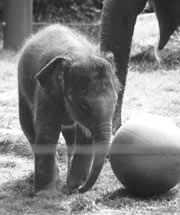Two months ago, Hansa, the Woodland Park Zoo’s baby-elephant star, became a problem child and a cause c鬨bre. She’d been eating dirt again, as she did with dogged persistence, defying the keepers who feared she’d fatally clog her young gut. Once again, a keeper blocked her mouth with the handle of his ankus (bullhook). Hansa butted him aside and swung her rump toward him—defiant gestures that will become deadly as she grows to her full 4 or 5 tons. The keeper, David Shrake, thumped her three times with the ankus, sending her running off bellowing and drawing both unflattering press coverage and a formal complaint to the U.S Department of Agriculture (USDA) animal-welfare watchdogs by People for the Ethical Treatment of Animals (PETA).
So how did Miss Supreme Happiness become so obstreperous? With a problem child, look for problem parenting—or surrogate parenting by keepers. That’s the evident conclusion to be drawn from the eye-opening videotapes logged by a particularly diligent elephant fan from Madison, Wis., named Julie Borodin. In May 2001 (before Shrake arrived and took charge of the barn), Borodin played hooky from her job as a graphic designer, came to Seattle, and spent seven days watching what went on in the elephant barn and yard. She observed the sort of mixed signals and inconsistent discipline that every parenting primer warns against. She inconspicuously filmed the elephant princess being allowed to play with a rubber tub used for bathing; on other occasions when the same tub was used for feeding, keepers struck Hansa with their ankuses when she tried to play with it. Likewise with a water hose: Sometimes she could play with it; at other times, she was reprimanded.
Borodin says she saw keepers strike Hansa when she crowded one keeper and ran at another. But on another occasion, she filmed the acting lead elephant keeper pushing back against Hansa when the eager tyke pushed forcefully against him—a response that could, in Borodin’s words, teach Hansa “to regard humans as play objects,” with disastrous results. She also filmed that keeper “staring down” Hansa and raising his ankus—warnings the then-6-month-old elephant “appeared not to understand.”
Borodin says she saw keepers strike Hansa with their ankuses “at least 11 times.” She also noted several problems with Seattle’s much-touted elephant house previously described in these pages: It’s “essentially a partitioned corridor,” inflexible and ill-suited to breeding. Sri and Bamboo, two adult elephants not considered safe around the new baby, suffered long confinement in a small shower room and dark quarantine room. They and Hansa’s mother, Chai, took to pacing and shuffling, signs of stress and boredom.
The soft-spoken Borodin says she’s not associated with any activist group. But her monitoring has had effects elsewhere. At Madison’s Henry Vilas Zoo, she filmed abuses more severe than any that are alleged at Woodland Park. Her tapes prompted a federal inspection and helped force Madison to relinquish its two elephants, one to a sanctuary and one to another zoo.
Now, after sitting on her Seattle tapes for 14 months, Borodin intends to file another USDA complaint against Woodland Park. She says she was roused to action by two concerns. First, like PETA, she questions whether the zoo is committing enough funds ($300,000 this year) and training to properly retrofit its facilities and switch to coercion-free “protected contact” as promised. Second, she felt goaded by the “deceit” of zookeepers stating (as reported in the July 24 Seattle Times) that “they use only the blunt end [of the ankus] to discipline the animal, never the hook.” Her tape shows one keeper striking Hansa with the hooked end (though not necessarily the hook itself), and she says she saw others do likewise.
Questioned on that point, Woodland Park’s publicity office first affirmed a “never with the hooked end” policy, then issued a clarification: Keepers may indeed strike with the blunt side of the ankus’ hooked end, but not with the hook itself. American Zoo and Aquarium Association guidelines forbid striking with the hook.
Whether the contradiction between the previously announced policy and actual practice stemmed from “deceit” or innocent confusion, at least some of Hansa’s problems—and the keepers’—have abated. Cavorting in the yard, she now tosses dirt on her back, the way an elephant is supposed to, rather than into her mouth. Why did she stop eating dirt? Apparently because keepers stopped trying so hard to stop her. Queried on that point as he addressed a crowd of visitors, Shrake, the new lead elephant keeper, explained that his crew had stepped back and started letting her swallow an “average” amount of dirt. When she couldn’t get a rise from them, she lost interest in eating dirt.
This simple change should greatly reduce elephant/keepers collisions of the sort Borodin recorded. Protected contact could reduce them even more.
Eric Scigliano’s environment column appears every other week.









